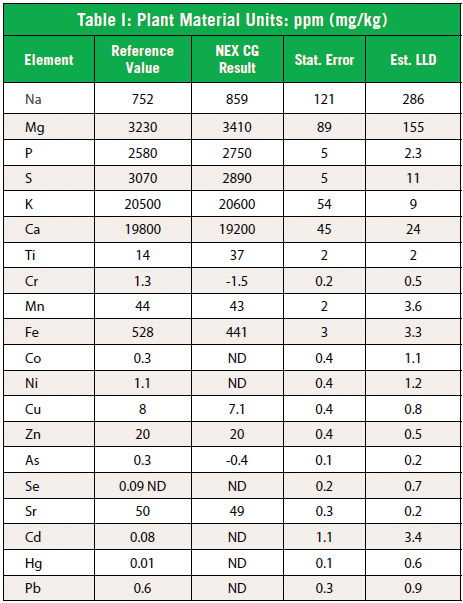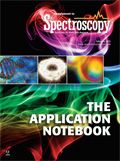Analysis of Agricultural Soils and Plant Materials
Application Notebook
In the agri-food sector it is important to not only study the soil composition and use of fertilizers, but also the uptake of nutrients and potentially toxic elements within the plants and crops themselves.
The analysis of agricultural soils and plant materials is demonstrated using EDXRF.
In the agri-food sector it is important to not only study the soil composition and use of fertilizers, but also the uptake of nutrients and potentially toxic elements within the plants and crops themselves. X-ray fluorescence (XRF) is an accepted technique in the industry.
Experimental Conditions
Instrument
The Rigaku NEX CG spectrometer meets the challenges of soil and crop analysis using indirect excitation EDXRF (Energy Dispersive XRF). Secondary targets and polarization give the operator high precision instrumentation with a simple and intuitive software design ideal for meeting demanding trace measurements as well as measurements of major and minor elements.
The Rigaku RPF-SQX Fundamental Parameters (FP) software automatically deconvolutes spectral peaks and models the sample matrix, X-ray absorption, and enhancement effects using fundamental XRF equations. Scattering FP is the Rigaku technique of using the measurement of the Compton and Thomson (Rayleigh) scatter peaks to gain valuable information about the sample matrix. The semi-quantitative measurements using RPF-SQX can be further optimized with the use of a Matching Library.
Sample Preparation
Samples are first ground to a dry, homogeneous powder <200 mesh (<75 μm particle size). Each powder sample is then made into a hydraulically pressed pellet using 20 tons pressure for 5 s. Plant materials use 3 g per sample, soils use 5 g per sample. If required, binder may be used to ensure a stable pellet. Soil samples typically require 0.5g of binder and 4.5 g of sample. If using binder, care should be taken to ensure a homogeneous mixture of binder and sample.
Analysis Results
Results-Plant Materials
Plant material and crops are mainly organic material with low inorganic levels exhibiting minimal or no mineralogical effects. Three samples of plant material were provided. Two of the samples were used to create a Matching Library, a procedure that is simple for the user to build. The remaining sample was measured as an unknown with results shown in Table I.

Table I: Plant Material Units: ppm (mg/kg)
Results-Soils
Soils are mainly inorganic with a low organic component. Sodium, magnesium, aluminum, silicon, potassium, calcium, and iron occur at high levels. The results, shown in the full report, show soil screening using standardless FP without the use of any reference soils.
Conclusion
Given homogenous samples, the Rigaku NEX CG yields excellent performance for the elemental analysis of plant materials and soils. If desired, FP standardless semi-quantification can be improved with Matching Libraries based on one or more assayed type standards of the particular material type. The NEX CG software is powerful and flexible, yet simple and intuitive to operate. These features make the NEX CG an ideal EDXRF tool for screening and characterization of plant materials and soils.
Applied Rigaku Technologies, Inc.
9825 Spectrum Drive, Bldg. 4, Suite 475, Austin, TX 78717
tel. (512) 225-1796, fax (512) 225-1797
Website: www.rigakuEDXRF.com
